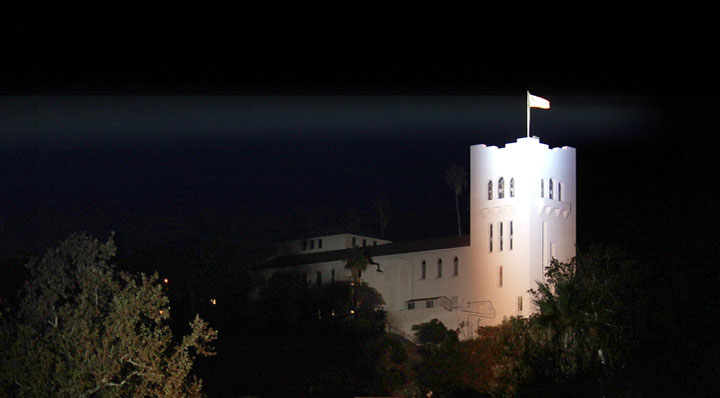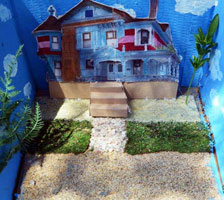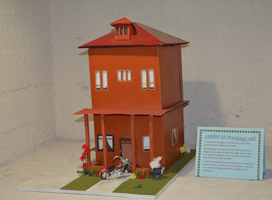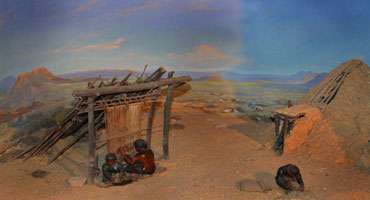August 16th, 2014
The sun was already high in the sky and beginning to beat down as local residents, representatives of community historical societies, and other interested parties converged on the Southwest Museum of the American Indian for the 100th anniversary of the building’s completion. The brainchild of Charles Lummis, the Southwest Museum’s building was completed in 1914 and it opened its doors shortly thereafter. It is the first and oldest museum in Los Angeles.
In order to reach the elevator which takes visitors directly upstairs into the lower level of the museum, patrons are first treated to a refreshing, quiet walk through the Mayan Tunnel, which heads directly into the mountain under the building.
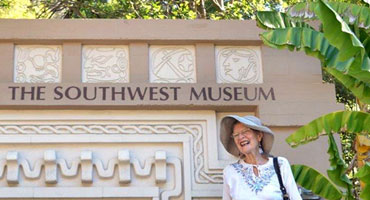
Ann Walnum arrives at the Mayan Tunnel for the Southwest Museum’s 100th Anniversary Celebration. Photo courtesy of Carol Teutsch
For this special occasion, the existing niches located along the length of the tunnel were filled with 17 dioramas produced by elementary school children from the Los Feliz Charter School for the Arts (LFCSA) and high school students from Franklin High School’s Advanced Placement Spanish Language and Culture classes. Louisa Van Leer, local architect and artist in residence at the LFCSA, helped lead over 100 students on a tour of historic sites surrounding Sycamore Grove Park and locations of natural beauty in the Arroyo Seco.
The student tours were an outgrowth of the Living Museum: Sycamore Grove, an exciting partnership with the Highland Park Heritage Trust and the Friends of the Southwest Museum that was created to draw attention to the wonderful resources in our area. The elementary students of LFCSA focused on the landscape, investigated the history of various sites in the Sycamore Grove area of Highland Park, and created dioramas that depicted how earlier generations of people lived on the land. The outstanding dioramas created by the high school students illustrated the many different types of architecture found in Highland Park, from American Foursquare to Spanish Colonial.
The Mayan Tunnel once constantly displayed dioramas from the Southwest Museum’s collection, but those dioramas are now in storage. However, the 100th anniversary of the building’s completion provided the perfect opportunity to put some newly created dioramas on display. When asked about the exhibition, Van Leer explained that having these student dioramas on view, as well as the display of one of the magnificent original Southwest Museum dioramas near the elevator, was a quietly momentous moment. The decision to display the dioramas in the tunnel was reached via communication with the Autry, and she described the situation as an olive branch. “We’re reaching out to them [the Autry] and they’re reaching out to us.” Opening the Mayan Tunnel to the public and displaying the results of a spectacular community effort was a positive gesture on the Autry’s part.
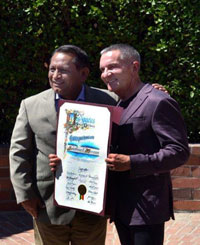
Councilmember Gil Cedillo presents a certificate to Rick West, CEO of the Autry National Center. Photo courtesy of Al C. Strange
The reception in the courtyard featured a buffet of breakfast items and hot coffee. Comments from Richard West, Jr., President and CEO of the Autry, and a presentation of a congratulatory certificate by District 1 Councilmember Gil Cedillo to the Southwest Museum, which was accepted by Mr. West, were the centerpieces of the ceremony.
Sprague Hall was nearly full for a panel-style lecture moderated by the Autry. The lecture included presentations from Mark Stankard, a local architect and professor of architecture at Woodbury University, Stephen Gee, author of Iconic Vision: John Parkinson, Architect of Los Angeles, Chris Morris, Los Angeles Field Director for the National Trust for Historic Preservation; and Liza Posas, Autry Archivist and Head Librarian of the Braun Research Library.
The Braun Research Library handled a flood of people who were interested in examining the maps and personal letters from the Charles Lummis collection that were on display, and in deference to the celebration of this building, the library offered “party favors” to visitors in the form of small reproductions of an early painting of the Southwest Museum. The Braun Research Library contains hundreds of thousands of books from the collection of Charles Lummis, who was himself a librarian. The collection is outstanding; some of the books in the library pre-date the invention of the Guttenberg printing press.
On the 100th anniversary of the building’s completion, the community continues to hope for a rebirth of the Southwest Museum. There are case studies of museums in Los Angeles that have successfully been revitalized. The Natural History Museum comes to mind immediately, with its soaring new architecture, lush outdoor gardens, café, Nature Lab, and Butterfly Pavilion (which changes to the Spider Pavilion in the fall). Similar plans for a multi-functional use of the Southwest Museum building have been proposed, including one from our very own Louisa Van Leer! Check it out by clicking on “Vision” and then “Museum” on the top menu bar of our website.
And to cap off the celebration, the Southwest Museum was illuminated with a spotlight, highlighting its status as a beacon of cultural importance on the East side of Los Angeles.

